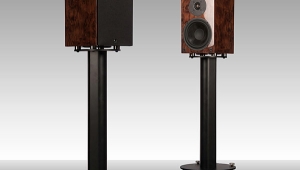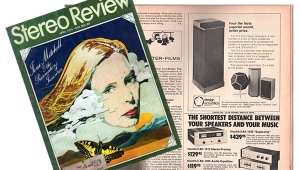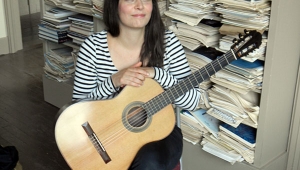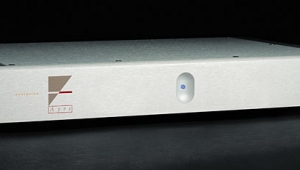| Columns Retired Columns & Blogs |
The Fifth Element #66 Page 2
Glenn Gould's two commercial recordings of J.S. Bach's Goldberg Variations should be in every educated person's store of cultural literacy. Gould recorded the Goldbergs as his major-label début in 1955, and revisited (having apparently reconsidered) them in 1981, shortly before his death. The received wisdom has long been that Gould repented of the brisk tempos, détaché phrasing, and percussive dynamics of his 1955 début, and veered to the polar opposites in his 1981 farewell.
Footnote 2: Direct Acoustics, 19 Lexington St., Weston, MA 02493. Tel: (617) 538-2015. Web: www.directacoustics.com.
However, that applecart of received wisdom not only has been upset, it now must be broken up and sold for firewood. Nearly everything we thought we knew is wrong. It turns out that in 1954, when Gould was on the brink of stardom, he played the Goldbergs for a live radio broadcast for CBC Toronto, and his performance was archived on acetate transcription discs.
If you care about Glenn Gould's recorded legacy, those acetates are world-shakers, for two reasons. First, in the broadest possible terms, the 1954 Goldbergs are closer to the 1981 than to the 1955 version in tempo and expression. Which means that the 1981 version was not so much a reconsideration as a revisitation. What does that suggest about the 1955 version? Was its overall sharpness (as opposed to roundedness) an artistic development, or just a good career move? I leave it to those who know a lot more about Gould's career as a whole to reach a judgment on that.
Second, the acetates prove that, at least that early in his career, Gould did not need tape editing as a crutch. I have listened a few times, and if there are clunkers, they went right past me. (I have long believed that Gould later obsessively messed around with editing from a perverse need to affront the bourgeoisie or from a need to have something to fill up his days, and not from shortcomings in keyboard technique.) As cruddy as the sound is, with limited dynamics and frequency extension, lots of swishing, and audible transitions between a quieter acetate blank and a noisier one, you can still clearly hear—even from another room—that this performance actually hangs together better than either of the famous ones. Not that the others don't draw you in, but this one really does.
Well, by this time, you probably know whether you need to own this. I picked up my copy (which also includes four preludes and fugues from The Well-Tempered Clavier, Book II) from the Berkshire Record Outlet for the princely sum of five bucks plus shipping. However, if those are gone, the same music is available—along with three of Beethoven's piano concertos and much more—in a superbargain set, Glenn Gould: The Young Maverick (6 CDs, CBC 2030): 6 hours and 51 minutes of Gould in glorious early-1950s mono, for $21.99 from ArkivMusic.com.
Direct Acoustics Silent Speaker II: The Different Drummer's Different Loudspeaker
Direct Acoustics is a loudspeaker company in Weston, Massachusetts, that sells, by mail-order only, just one product: the two-way, floorstanding Silent Speaker II ($748/pair, footnote 2).
Its seemingly paradoxical name refers not to any inability of the Silent to create sound, but rather is intended by its maker to indicate two aspects of its performance. First is the ability of the loudspeaker boxes to "disappear" in the sense of not being readily apparent as sound sources. Well, okay, everyone wants that. The other intended sense of Silent is that the woofer and its loading arrangement were designed to minimize stray noises created by the woofer's excursion, or by the movements of air within, or in and out of, its vent or port.

Direct Acoustics, founded in 1995, is the brainchild of Winslow Burhoe, an important figure in the history of modern loudspeaker design. In 1960, Burhoe had been studying pipe organ at the New England Conservatory when he was chosen for an internship at Acoustic Research, and the direction of his life was set. He assisted Edgar Villchur on the design of the AR4. He went on to found EPI/Epicure loudspeakers (later acquired by Harman International), Burhoe Acoustics, and Direct Acoustics. (He influenced designs from KLH, Snell, Boston Acoustics, Audio Products International (aka API, and for whom he reworked a late prototype of the Energy 22), and others.
The Silent Speaker II is a wide, rectangular box whose top panel is raked at an angle of about 22°: the enclosure is about 22" tall at the front, 25" tall at the rear, 13.5" wide, and 9" deep. The top panel holds a 6.5" woofer and a 1" soft-dome tweeter. Each speaker weighs about 25 lbs. A recess in the upper part of the rear panel holds one pair of binding posts with red and black plastic hex nuts. The pairs are mirror-imaged; I positioned them with the tweeters to the inside. A port about 1" tall runs nearly the full width of the bottom of the front panel. The speakers come with grilles of stretched black fabric that are secured to the top panel with squares of adhesive foam. The edges of the enclosure are rounded, with a round, compliant foot about 1/4" thick at each corner.
The Silent Speaker II is available in one finish: black ash veneer. Its monolithic look isn't really contemporary, but the design brief doesn't appear to have been "Sound okay and win beauty contests." Compared to recent offerings from any number of companies—such as PSB, whose curved enclosures are elegantly veneered and stained—the Silent looks a bit dated, even DIY. But I don't think that that will matter to the right customers, who will ignore the styling and the somewhat handmade look of the woofer cones, and enjoy a much wider frequency extension than is offered by any other basically listenable loudspeaker at or near its price.
Direct Acoustics claims for the Silent Speaker II frequency responses of 40Hz–10kHz, ±2dB; 30Hz–17kHz, ±4dB; and 20Hz–20kHz, ±6dB (!). No sensitivity is specified. Also stated are impedances of 6 ohms average and 4 ohms minimum.
Visually and, to an extent, through its acoustical approach, the Silent Speaker II calls to mind three venerable speakers from what I term a Golden Age of Audio (1970s–1980s): Stig Carlsson's Sonab omnidirectional, Shahinian Acoustics' Arc polyradial, and the Epicure Model 20. All are rather squat floorstanders that fire as much toward the ceiling as toward the front, but after that the similarities taper off.
Footnote 2: Direct Acoustics, 19 Lexington St., Weston, MA 02493. Tel: (617) 538-2015. Web: www.directacoustics.com.
- Log in or register to post comments




































